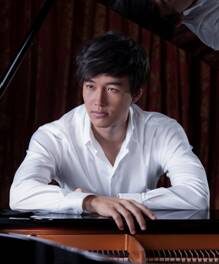Not having scrutinized my program booklet with sufficient care, I was rather flummoxed when, instead of Augustin Dumay, a woman strode forth onto the Belk Theater stage with Charlotte Symphony Orchestra maestro Christopher Warren-Green to play the Brahms Violin Concerto in D. It was then that I examined the blue leaflet behind the front page of my program and discovered that I was about to hear Adele Anthony’s Charlotte debut instead of Dumay’s. I quickly recalibrated my expectations for the Brahms, which I’d previously heard at the Belk in a lackluster performance by Viviane Hagner in 2007, just three years after 21-year-old Julia Fischer served notice that she was the real thing in a display of “precision and crusading fire,” to quote my own reaction, with the touring Dresden Philharmonic.
It’s unclear whether the CSO, which surely had more advance notice than I did, recalibrated their accompaniment to suit a soloist who is less fiery and flamboyant than either Dumay or Fischer. From the outset, Anthony sounded underpowered in the Allegro non troppo, with the flute – dominant behind the soloist in my recordings showcasing David Oistrakh, Maxim Vengerov, and Joshua Bell – fairly obliterating the soloist here. When softness was warranted, Anthony drew lovely tones from her Stradivarius with a full vibrato, and her second statement of the familiar theme had more thrust and fire, but the double-bowing deeper in the movement needed more gusto. The cadenza, more suited to Anthony’s introspective style, came off quite magically, very consonant with the dreamy orchestral introduction to the ensuing Adagio, featuring Hollis Ulaky’s oboe wafting over the other woodwinds. Again, there were moments when Anthony was somewhat upstaged by Elizabeth Landon’s flute or Frank Portone’s horn, but her grasp of the melodic argument was expressed with captivating fluidity and tone. Anthony certainly attacked the jubilant Allegro giocoso with spirit, but more power was needed from the soloist before the orchestra’s second response – or perhaps more restraint from Warren-Green and his forces. No chivalry was forthcoming with the onset of the brass later on in the finale, further underscoring the imbalance of power.
Chivalry was the last thing you’d want in the second half of the program with Shostakovich’s Symphony No. 5 in D minor. Unhampered by a soloist whose fire came only intermittently, Warren-Green and the CSO were able to replicate the lyrical muscle they had flashed two weeks earlier in Brahms’ Symphony No. 3 – and the manic abandon lavished on Ravel’s La Valse – under the baton of guest conductor Larry Rachleff. Perhaps that’s an understatement, for with an eight-man brass section, two harps, a pianist, and five other percussionists, the power waiting to be unleashed was positively shell-shocking. Unless you had read the program notes, you might have assumed that the forlorn desolation of the opening Moderato was in the wake of a nuclear catastrophe – or the colossal bloodshed of WW2 – rather than the expression of the sufferings of a downtrodden individual, composed in 1937 rather than 1945. Surely there is no mistaking the irresistible march that overtakes this dreary mindscape, fiercely trampling all that suffering with salvos of percussion and manifestos of brass, for anything but the inglorious Stalinist regime. A quiet sickly sweetness lingered in the wake of the military thunder, with a wan piccolo statement from Erin Frechette leading seamlessly into a lament by concertmaster Calin Lupanu before a fadeout of two trumpets over a celesta.
Introduced by cellos and double-basses, the ensuing Allegretto is like a satanic scherzo in 3/4 time. The French horns announced the main theme with a boozy dissonance, almost gracefully taken up by Lupanu before Landon took over with just a slight limp. While the strings inserted their pizzicato interlude, all the brass and percussion held their sticks, mallets, and instruments at-the-ready for the return of the main theme. I raised my binoculars and scanned the string section to confirm the singular beginning of the elegiac Largo – launched exclusively by the back-bench players! The highest-ranking first violins were the last to join the string ensemble in a theme that reminded me of Barber’s famed Adagio (Shostakovich’s 1937 work lies between the 1936 string quartet and the 1938 better-known orchestration). Two flutes, Landon’s and Amy Whitehead’s, keened pitifully before the strings began a long, slow build that seemed destined to explode. Instead, the strings subsided to their softest pianissimo as Ulaky played an oboe solo over their throbbing. Eugene Kavadlo offered up a tentative monologue on clarinet before darkness came over the strings and another lament by the flutes was engulfed in a wan depression of woodwinds. One harp and the celesta sounded the slow exit from this dismal listlessness.
Apologizing for his satirical Lady Macbeth of Mtsensk, Shostakovich crafted this symphony as a “Creative Reply to Just Criticism,” declaring that his new work was a paean to the individual, lyrical from beginning to end, with a finale that “resolves the tragedy and tension of the earlier movements on a joyous, optimistic note.” Either Shostakovich was audaciously dissembling in his attempt to regain Stalin’s favor, or Warren-Green was wildly misinterpreting the composer’s intent. Unless you find the opening of Strauss’s Zarathustra joyous and optimistic, you probably would have heard Charlotte Symphony’s account of Shostakovich’s closing Allegro non troppo as muscular, militant, and fearsome – perhaps slightly terrifying. All eight of the brass players heralded the march, which seemed to evoke the mobilization of all the Russias. Portone and Landon soloed ably in the wake of the onslaught before two plinking harps signaled an end to the lull. The woodwinds sounded oddly regimented and mechanical before the strings poured out pure emotion. Leonardo Soto’s timpani triggered the triumphal climax. Then it stamped that loud collective triumph with all the fateful Nietzschean indomitability that Strauss had envisioned. As the crowd rose enthusiastically to their feet, it was obvious that Warren-Green had made his point.













